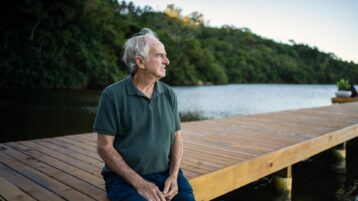
Meet the woman behind the Private Giving Foundation
The Private Giving Foundation was the first-of-its-kind fund in Canada. Jo-Anne Ryan, Executive Director and architect of the foundation speaks to us about the value of flexible giving and how you can make an impact with your good fortune.
It has been nearly 20 years since Jo-Anne Ryan, Vice President, Philanthropic Advisory Services at TD Wealth, helped launch the Private Giving Foundation. Since then, more than half a billion dollars has been distributed to charities. Ryan, who is also Executive Director of the foundation, spoke to MoneyTalk about the continuing appeal of the foundation for Canadians, and how it is making a difference both at home and overseas.
MoneyTalk: How did the Private Giving Foundation come about and what was your involvement?
Jo-Anne Ryan: The Private Giving Foundation (PGF) is structured as a “donor-advised fund.” These were pioneered in the U.S. during the 1990s. I had been attending charitable giving conferences in Canada where we began hearing about these giving vehicles. I put a proposal together and approached TD to be the first financial institution in Canada to launch a donor-advised fund. I came aboard and we launched the Private Giving Foundation in October 2004.
The Private Giving Foundation has its own registered charity number and its own board of directors. While it’s independent from TD, the bank put up the seed money to build it and there’s a service agreement between the foundation and TD for TD to do all the administration associated with running it.
Generally, it is structured so that charitable donors set up an account within PGF and give it a name (for example, “Smith Family Foundation”). They can donate cash or publicly traded securities to the PGF. Then they can grant to charities from their fund at any time. Funds are invested and grow tax-free which helps maximize what can be distributed to charities.
MT: That was almost 20 years ago. What’s the journey been like?
JR: It’s been extremely gratifying. You get to meet donors and philanthropists and help them fulfill their passions around the causes they care about. A great example: Husband and wife philanthropists from Alberta, David and Christine Anderson, have a home on Bequia, a small island that forms part of St. Vincent and the Grenadines in the Caribbean. While they enjoyed the benefits of a tropical retirement, they also wanted to help fix the systemic poverty on the island. Through the PGF, the Andersons were able to set up their fund, the DC Anderson Foundation. Now, charitable projects in other countries are typically hard to get off the ground. Fortunately, the Andersons were able to partner with an international charity that specializes in working in developing countries. That partnership allowed the Andersons to fund projects such as education for students with special needs, scholarships, food security programs and COVID-19 vaccines in Bequia. They’ve even transported entire playgrounds for the children to the island.
MT: The practice of charitable giving can clearly be fraught with complications. How can other Canadians make the greatest impact with their money?
JR: Canadians like the Andersons care greatly about their charities. But the traditional way of setting up a charitable foundation means legal fees, administration and governance oversight. It can be very time consuming. It may take a year to get registered by the Canada Revenue Agency (CRA). If you sit on the board of your own charity, you will also have the fiduciary responsibility of making sure you are in compliance with all of the CRA’s rules when it comes to charity regulations, as well as the Income Tax Act. For most Canadians, this is not feasible.
With the PGF, you can immediately set up your own foundation with $10,000 and with the help of a financial advisor. We’ve made charitable giving on this scale accessible to many more people. Moreover, you don’t need to decide immediately where you want your charitable donation to go: With the PGF you can take your time to research which of Canada’s numerous charities are appropriate. In the meantime, your money is invested and continues to grow, and you can get immediate tax benefits. There is no need to rush to meet a December 31 deadline to receive a tax receipt as you would if you were making a donation directly to a charity.
MT: We’ve recently seen natural disasters hit both eastern Canada and southern parts of the U.S. If your account is already set up, can you add another charity quickly if there is a sudden call for funds?
JR: Absolutely. When you set up a fund within the PGF, you don’t necessarily have to designate a charity or grant recipient right away. In this way, you can have funds available if there are immediate needs or an emergency.
Because of this flexibility, a family could have each family member choose their own charity annually, something that aligns with their personal values or interests, and then their account can make grants to those charities. In this way, the older members of a family can be role models and educate their children around philanthropy by getting them to participate in the process.
MT: Are there other ways to give besides a cash donation?
JR: The PGF has built-in flexibility that benefits both donors and their charities. People can donate appreciated publicly trades securities. The donor benefits from receiving a donation receipt for the market value of the securities, while capital gains taxes are eliminated. Through their estate plan, people can also donate assets through their Will or make the PGF the beneficiary of their registered plan or Tax-Free Savings Account.
MT: Lastly, do you have a favorite charitable interest?
JR: I have a bunch. At Carleton University, they have a Master of Philanthropy and Nonprofit Leadership program — it’s the only one of its kind in Canada. I’m on the advisory board and it’s going to celebrate 10 years this year. Why is that important to me? If Canadians are donating to a charity, we want that charity to be well-run. By investing in a program like Carleton’s, which is creating the leaders who will be able to guide organizations really effectively, it benefits the whole charitable sector.
DON SUTTON
MONEYTALK LIFE
ILLUSTRATION
INNA GERTSBERG















